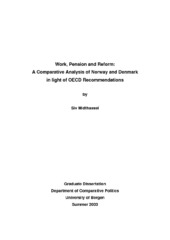Work, Pension and Reform: A Comparative Analysis of Norway and Denmark in light of OECD Recommendations
Master thesis
Permanent lenke
https://hdl.handle.net/1956/1618Utgivelsesdato
2003Metadata
Vis full innførselSamlinger
Sammendrag
The thesis addresses the subject of ageing societies resulting from demographic trends of population, individual and active ageing. Societies are aging across the world, but the focus of this study is the OECD area in general and Norway and Denmark in particular, selected because they represent the Scandinavian welfare state. The thesis opens with a description of current and projected demographic patterns, and the social, fiscal and political challenges they pose, which are relevant to most OECD countries although to various degrees. In responding to the challenges of ageing populations OECD outlines seven principles for reform, of which I primarily address the ones related to the pension system, pension income and the employability of older workers. The primary focus of attention is responses to the challenges of ageing in light of OECD recommendations as reflected in current reforms. In order to better comprehend and hypothesise the plausibility that Norwegian and Danish reforms comply with the OECD view, I have chosen a normative perspective. I presume that to the extent the normative foundations embedded in the OECD recommendations are reflected in the pension systems in Norway and Denmark, they may be more inclined to follow the OECD direction, than would otherwise be the case. The normative values of the pension systems are considered according to the normative foundations of the Scandinavian welfare state, notably public responsibility, universality, generosity and full employment. I find that the normative principles of OECD and the Scandinavian welfare state diverge, except regarding the aspect of employment. By including the actual pension systems, the hypothesis is less clear-cut as both entail elements of the OECD view. I find that implemented and/or proposed pension reforms primarily comply with OECD recommendations, although some recommendations are ignored and/or not adopted altogether. I do not as of yet, find indications that either country is moving away from the Scandinavian welfare state. In my opinion Denmark, which I consider a forerunner as compared to Norway in implementing reforms, appears to have successfully combined the “best of two worlds”, by incorporating OECD recommendations within its overall Scandinavian welfare state. Whether Norway will follow suit, remains to be seen.
Utgiver
The University of BergenOpphavsrett
The authorCopyright the author. All rights reserved
